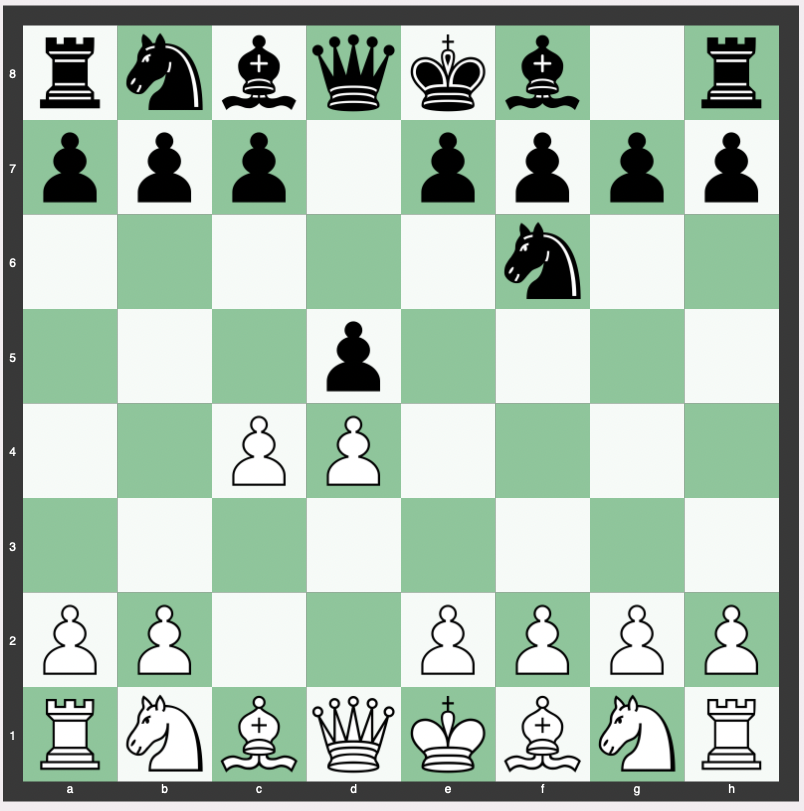The Marshall Defense is a unique and somewhat unconventional chess opening that begins with the moves 1.d4 d5 2.c4 Nf6 out of the popular Queen’s Gambit opening.
It can lead to a variety of fascinating positions, providing a rich playing experience for both players.
This article will explore the Marshall Defense, covering its move order, theory, strategy, purpose, variations, history, suitability for beginners or intermediates, and its frequency at the grandmaster level.
Move Order of the Marshall Defense
1.d4 d5
2.c4 Nf6

This sequence of moves is the foundation of the Marshall Defense, beginning with 1.d4 and 1…d5 to establish central control, followed by 2.c4 and 2…Nf6, challenging White’s control and inviting various responses.
Theory, Strategy and Purpose of the Marshall Defense
The main theory behind the Marshall Defense is to disrupt White’s control of the center.
By playing 2…Nf6, Black aims to prevent an immediate 3.e4 by White, challenging the center and creating counterplay opportunities.
The strategy of the Marshall Defense is aggressive and combative, attempting to complicate the game and create tactical chances.
Its purpose is to surprise an unprepared opponent, steering the game into less explored territories.
Variations of the Marshall Defense
The main variations of the Marshall Defense can lead to complex and tactical play.
Some of the popular variations include:
- Mainline Variation: 3.Nc3, where White develops a piece and continues to support the c4 pawn.
- Modern Variation: 3.g3, focusing on fianchettoing the king’s bishop, aiming for a hypermodern approach. Takes away white’s advantage, however.
- Sound Variation: 3.cxd5, which is considered the most theoretically accurate.
Each variation has its own nuances, and understanding them is crucial for anyone aiming to adopt this defense.
Evaluation of the Marshall Defense
The evaluation of the Marshall Defense is +0.70 to +0.80.
Sample Continuation Lines of the Marshall Defense
Continuation lines of the Marshall Defense include:
3. cxd5 g6 4. Nf3 Bg7 5. Qa4+ c6 6. dxc6 Nxc6 7. Nc3 Bf5 8. e3 O-O 9. Bb5 Rc8 10. O-O Ne4 11. Nd2 Nxc3 12. bxc3 a6 13. Be2 b5 14. Qxa6 b4 15. cxb4 Nxb4
3. cxd5 g6 4. Qa4+ c6 5. dxc6 Nxc6 6. Nf3 Bg7 7. Nc3 Bf5 8. e3 O-O 9. Bb5 Rc8 10. O-O Ne4 11. Be2 a6 12. Qd1 e5 13. Nxe4 Bxe4 14. Nd2 Bf5 15. e4 Bd7 16. d5 Nd4 17. Bd3 f5 18. a4 fxe4 19. Nxe4 Bf5 20. Nc3 Qh4
3. cxd5 g6 4. Nf3 Bg7 5. Qa4+ c6 6. dxc6 Nxc6 7. Nc3 Bf5 8. e3 O-O 9. Bb5 Rc8 10. O-O a6 11. Bxc6 Rxc6 12. Bd2 Rb6 13. b3 Rc6 14. Rfc1 Ne4 15. Nxe4 Bxe4 16. Qa5 Qd7 17. Rxc6 Bxc6 18. Ne5
3. cxd5 g6 4. Nf3 Bg7 5. Qa4+ c6 6. dxc6 Nxc6 7. Nc3 Bf5 8. e3 O-O 9. Bb5 Rc8 10. O-O Ne4 11. Nd2 Nxc3 12. bxc3 Bd7 13. Qd1 Qa5 14. c4 a6 15. Nb3
History of the Marshall Defense
The Marshall Defense is named after Frank Marshall, a U.S. Chess Champion and one of the world’s strongest players in the early 20th century.
Marshall introduced this defense in his practice, and although it was never his primary weapon, it left a significant mark in chess theory.
Over time, the Marshall Defense has seen sporadic use by other players but has not become a mainline opening.
Is the Marshall Defense Good for Beginners or Intermediates?
The Marshall Defense is generally considered more suitable for intermediate and advanced players rather than beginners.
Its unorthodox nature requires a good understanding of tactics and positional nuances.
While it can be an intriguing choice for a beginner looking to explore new ideas, its complexity might make it challenging to handle without sufficient experience.
How Often Is the Marshall Defense Played at the Grandmaster Level?
The Marshall Defense is rarely seen at the grandmaster level.
Its unconventional character makes it less appealing to top players who tend to prefer more sound and established openings.
However, it can occasionally be used as a surprise weapon in specific tournament situations, especially against an opponent who may not be well-prepared for it.
Chess Openings: Kasparov’s Refutation of The Marshall Defense
Conclusion
The Marshall Defense is an intriguing and bold opening that challenges traditional chess principles.
With its unique move order and complex variations, it offers an alternative approach to controlling the center and combating White’s setup.
While not a common choice among top-level players, the Marshall Defense retains a certain charm and can be an effective weapon for intermediate players or those looking to explore less trodden paths in the opening phase of the game.
Its history, rooted in one of America’s chess legends, and its adventurous spirit make the Marshall Defense a fascinating part of the rich tapestry of chess.


